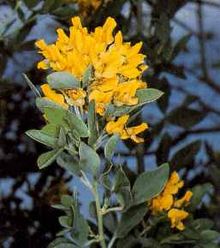Goat clover
| Goat clover | ||||||||||||
|---|---|---|---|---|---|---|---|---|---|---|---|---|

Common broom ( Cytisus scoparius ) |
||||||||||||
| Systematics | ||||||||||||
|
||||||||||||
| Scientific name | ||||||||||||
| Cytisus | ||||||||||||
| L. |
The cytisus ( Cytisus ) is a genus ginster similar shrubs from the family of the Leguminosae (Fabaceae).
description
These are shrubs that are heavily branched everywhere, at least at the bottom. Depending on the species, they can reach heights of between 30 and 300 centimeters. Some species form long underground runners.
The leaves are pinnate in three parts or fingered to simple and narrow. There are also species that show both leaf shapes or that are almost leafless.
The mostly yellow, in some species also white flowers can be in terminal, upright, long ( Lembotropis ) or short racemose inflorescences , or too few in the leaf axils ( Sarothamnus ). In contrast to similar genera, the calyx of the flowers is hardly longer than wide. The two upper teeth of the calyx are roughly the same size as the three lower teeth. The peduncle is about as long or longer than the calyx.
Distribution and location requirements
Most species prefer to grow in dry, stony places such as dry meadows, sparse forests or on rocky slopes.
In contrast to most of the similar genera, which are mainly found in western Europe , which is dominated by the ocean , some goose clover species also occur in more continental climates as far as western Asia. The Mediterranean area is particularly rich in species .
Systematics



A description of the genus is difficult since the delimitation to similar genres like laburnum ( Laburnum ), dwarf broom ( Chamaecytisus ) and broom ( Genista is unclear) and is handled very differently depending on the weighting of the characteristics of different authors. Furthermore, the genera Sarothamnus , Corothamnus and Lembotropis are often separated from Cytisus . The classification has so far been based on purely morphological features. The genus has between 30 and 70 species.
The description in this article refers to cytisus including sarothamnus , corothamnus and lembotropis , but excluding chamaecytisus .
Here is a list of species and hybrids according to GRIN:
- Cytisus aeolicus cast. ex Lindley
- Cytisus arboreus (Desf.) DC.
- Cytisus ardoini E. Fourn.
- Cytisus baeticus (Webb) Steud.
- Cytisus balansae (Boiss.) Ball
- Cytisus × beanii G. Nicholson : Hybrid Cytisus ardoini × Cytisus purgans
- Cytisus cantabricus (Willk.) Rchb.f.
- Cytisus caucasicus Grossh.
- Cytisus commutatus (Willk.) Briq.
- Cytisus × dallimorei Rolfe : Hybrid Cytisus multiflorus × Cytisus scoparius 'Andreanus'
- Decumbent goat clover ( Cytisus decumbens (Durande) Spach )
- Cytisus filipes Webb & Berthel.
- Cytisus galianoi Talavera & PEGibbs
- Cytisus glabratus link
- Cytisus grandiflorus DC.
- Cytisus × kewensis Bean : Hybrid Cytisus ardoinii × Cytisus multiflorus
- Cytisus multiflorus (L'Hér.) Sweet
- Black-growing goat clover ( Cytisus nigricans L. )
- Cytisus oromediterraneus Rivas Mart. et al.
- Cytisus × praecox Bean : Hybrid Cytisus multiflorus × Cytisus purgans
- Common broom ( Cytisus scoparius (L.) Link )
- Cytisus striatus (Hill) Rothm.
- Teideginster ( Cytisus supranubius (Lf) Kuntze )
- Cytisus valdesii Talavera & PE Gibbs
- Cytisus × versicolor Dippel : Hybrid Cytisus hirsutus × Cytisus purpureus
- Three-flowered goat clover ( Cytisus villosus Pourr. )
- Cytisus virescens Wohlf.
Here is a list of the Central European species:
- Decumbent goat clover ( Cytisus decumbens (Durande) Spach )
- Sweet pea clover ( Cytisus emeriflorus Rchb. )
- Black-growing goat clover ( Cytisus nigricans L. )
- Cytisus procumbens (W. & K.) ex Willd.) Spreng.
- Common broom ( Cytisus scoparius (L.) Lk. )
Today no longer included in the genus Cytisus (selection):
- Cytisus alpinus Mill. → Laburnum alpinum
- Cytisus argenteus L. → silver husk ( Argyrolobium zanonii )
- Cytisus austriacus L. → Chamaecytisus austriacus
- Cytisus candicans (L.) DC. → Genista monspessulana
- Cytisus hirsutus L. → Chamaecytisus hirsutus
- Cytisus laburnum L. → Laburnum anagyroides
- Cytisus monspessulanus L. → Genista monspessulana
- Cytisus purpureus Scop. → Chamaecytisus purpureus
- Cytisus ratisbonensis Schaeff. → Chamaecytisus ratisbonensis
- Cytisus supinus L. → Chamaecytisus supinus
use
Some species and their hybrids are used as ornamental plants , including the many-flowered gorse , the Spanish goose clover ( Cytisus multiflorus (L'Hér.) Sweet) and the ivory gorse ( Cytisus × praecox Beauverd).
The broom broom ( Cytisus scoparius (L.) Lk.) Is often used to plant embankments.
Sources and further information
Single references
literature
- Gordon Cheers (Ed.): Botanica . Random House Australia 2003. German edition: Tandem Verlag GmbH 2003, ISBN 3-8331-1600-5 .
- Dietmar Aichele, Heinz-Werner Schwegler: Our grasses . 7th edition. Franckh'sche Verlagsbuchhandlung, Kosmos-Naturführer, Stuttgart 1984, ISBN 3-440-05284-2 .
- Henning Haeupler , Thomas Muer: picture atlas of the fern and flowering plants of Germany (= the fern and flowering plants of Germany. Volume 2). Published by the Federal Agency for Nature Conservation. Ulmer, Stuttgart 2000, ISBN 3-8001-3364-4 .
- Werner Rothmaler : Excursion flora for the areas of the GDR and the FRG . Volume 2: Vascular Plants, 14th Edition. People and knowledge, Berlin 1988, ISBN 3-06-012539-2
- Otto Schmeil , Jost Fitschen , Werner Rauh : Flora of Germany and its adjacent areas . 84th edition. Quelle & Meyer, Heidelberg 1968.
- Urania plant kingdom . Volume 4: Flowering Plants 2, 1st edition. Urania-Verlag, Leipzig 1994, ISBN 3-332-00497-2 .


